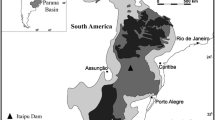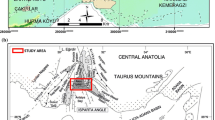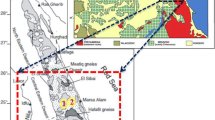Abstract
Most of the rocks in Precambrian shield areas have experienced a complex structural and metamorphic evolution, processes which have a strong influence on the bedrock quality. This may vary both on a local and regional scale. The main object of this investigation was to study the variation of the rock mechanical properties at various stages of ductile deformation of an originally isotropic rock. Ten samples from five different localities northeast of Lake Vänern (south central Sweden) were tested, including studded tyre and LA tests, uniaxial compressive strength (UCS), ultrasonic velocity, electrical resistivity, Swedish impact value and Swedish flakiness index as well as petrographic and chemical analyses. This study highlights the importance of considering all possible variations in bedrock before classification, and of undertaking regional investigations.
Résumé
Dans les régions du bouclier précambrien, la plupart des roches ont connu une évolution structurale et métamorphique complexe, ce qui a une forte influence sur la qualité du bedrock. Celle-ci peut varier à la fois à l’échelle locale et à l’échelle régionale. Le principal objectif de la recherche a été d’étudier la variation des propriétés mécaniques d’une roche initialement isotrope à différents stades de déformation ductile. Dix échantillons de cinq lieux différents au nord-est du lac Vänern (au centre-sud de la Suède) ont été soumis à des essais, dont l’essai de résistance à l’abrasion provoquée par les pneus à crampons, l’essai Los Angeles, la résistance à la compression uniaxiale, la vitesse des ultrasons, la résistivité électrique, l’essai suédois de résistance à la fragmentation par impact et le coefficient d’aplatissement suédois, mais aussi des analyses pétrographiques et chimiques. L’étude met en évidence l’importance qu’il y a à prendre en considération toutes les variations possibles dans le bedrock avant d’établir une classification et de procéder à des recherches régionales.








Similar content being viewed by others
References
Barton N, Lien R, Lunde J (1974) Engineering classification of rock masses for the design of tunnel support. Rock Mech 6(4):189–236
Broch E, Franklin JA (1972) The point load strength test. Int J Rock Mech Min Sci 9:669–697
Brook N (1993) The measurement and estimation of basic rock strength. In: Hudson J (ed) Comprehensive rock engineering: principles, practice and projects, vol 3. Rock testing and site characterization. Pergamon Press, pp 41–81
EN 1097-2 (1997)Tests for mechanical and physical properties of aggregates. Part 2: Methods for the determination of the resistance to fragmentation. European Committee for Standardization
EN 1097-9 (1997) Determination of the wear by abrasion from studded tyres—Nordic test. European Committee for Standardization
FAS-METOD 209-98 (1998) Bestämning av flisighetstal. Föreningen för asfaltbeläggningar i Sverige
FAS-METOD 210-98 (1998) Bestämning av sprödhetstal. Föreningen för asfaltbeläggningar i Sverige
FAS-METOD 221-98 (1998) Bestämning av kornstorleksfördelning genom siktningsanalys. Föreningen för asfaltbeläggningar i Sverige
FAS-METOD 244-98 (1998) Bestämning av LT-index. Föreningen för asfaltbeläggningar i Sverige
FAS-METOD 259-98 (1998) Bestämning av kulkvarnsvärde. Föreningen för asfaltbeläggningar i Sverige
Hawkins B (1998) Aspects of rock strength. Bull Eng Geol Environ 57:17–30
International Society for Rock Mechanics (1985) Point load test index I S(50). ISRM
Juhlin C, Wahlgren C-H, Stephens MB (2000) Seismic imaging in the frontal part of the Sveconorwegian Orogen, south-western Sweden. Precambrian Res 102:135–154
Page LM, Stephens MB, Wahlgren C-H (1996) 40Ar/39Ar geochronological constraints on the tectonothermal evolution of the Eastern Segment of the Sveconorwegian Orogen, south-central Sweden. In: Brewer TS (ed) Precambrian crustal evolution in the North Atlantic Region. Geol Soc Spec Publ 112:315–330
Persson L, Schouenborg B (1996) Quality classification of rock in Sweden. European aggregates. Official Journal of UEPG. Union Européenne des Producteurs de Granulats. UEPG 2–3/96:32–37
Söderlund U, Jarl L-G, Persson P-O, Stephens, MB, Wahlgren C-H (1999) Protolith ages and timing of deformation in the eastern, marginal part of the Sveconorwegian Orogen, southwestern Sweden. Precambrian Res 94:29–48
Stenlid L (1996) Klassificering av bergarter med Los Angeles-trumma. Slutrapport SBUF projekt nr 2135. Skanska Mellansverige AB. Väglaboratoriet Bålsta. 39 pp
Stenlid L (2000) Utvärdering av micro-Devalmetoden. Slutrapport SBUF projekt nr 5002. Skanska Mellansverige AB. Vägtekniskt Centrum Nord. Bålsta. 25 pp
Stephens MB, Wahlgren C-H, Weijermars R, Cruden AR (1996) Left-lateral transpressive deformation and its tectonic implications, Sveconorwegian Orogen, Baltic Shield, southwestern Sweden. Precambrian Res 79:261–279
Svensk Standard (1983a) SS 13 72 30. Betongprovning—Hårdnad betong—Tryckhållfasthet
Svensk Standard (1983b) SS 13 72 40. Betongprovning—Hårdnad betong—Ultraljudshastighet med 200 kHz standardtransducer på ändarna av provcylinder
Wahlgren C-H (1992) Berggrundskartan 10E Karlskoga NV. Sveriges geologiska undersökning Af 176
Wahlgren C-H (1993) Berggrundskartan 10E Karlskoga SV. Sveriges geologiska undersökning Af 182
Wahlgren C-H, Cruden AR, Stephens MB (1994) Kinematics of a major fan-like structure in the eastern part of the Sveconorwegian Orogen, Baltic Shield, south-central Sweden. Precambrian Res 70:67–91
Wahlgren C-H, Heaman, LM, Kamo S, Ingvald E (1996) U-Pb baddeleyite dating of dolerite dykes in the eastern part of the Sveconorwegian Orogen, south-central Sweden. Precambrian Res 79:227–237
Acknowledgements
The financial support provided by the Geological Survey of Sweden (SGU) is greatly acknowledged. Jan-Erik Lindqvist read an early draft of the manuscript and provided valuable comments. Sven Lundqvist is thanked for assistance with the microscopic work, and Barbara Rosborg for correcting the English.
Author information
Authors and Affiliations
Corresponding author
Rights and permissions
About this article
Cite this article
Göransson, M., Persson, L. & Wahlgren, CH. The variation of bedrock quality with increasing ductile deformation. Bull Eng Geol Environ 63, 337–344 (2004). https://doi.org/10.1007/s10064-004-0248-3
Received:
Accepted:
Published:
Issue Date:
DOI: https://doi.org/10.1007/s10064-004-0248-3




